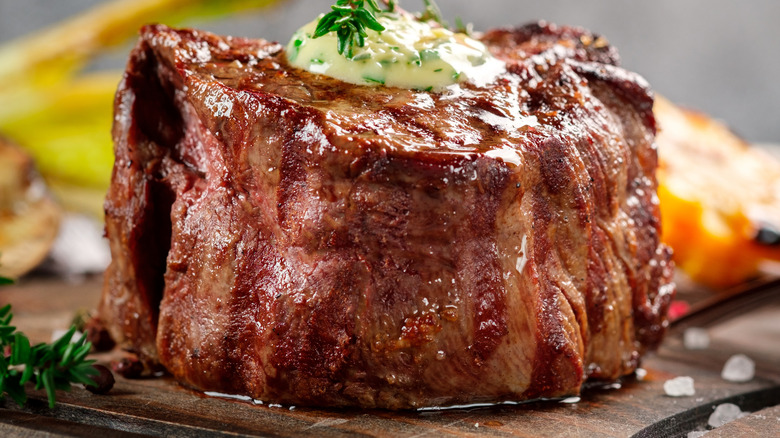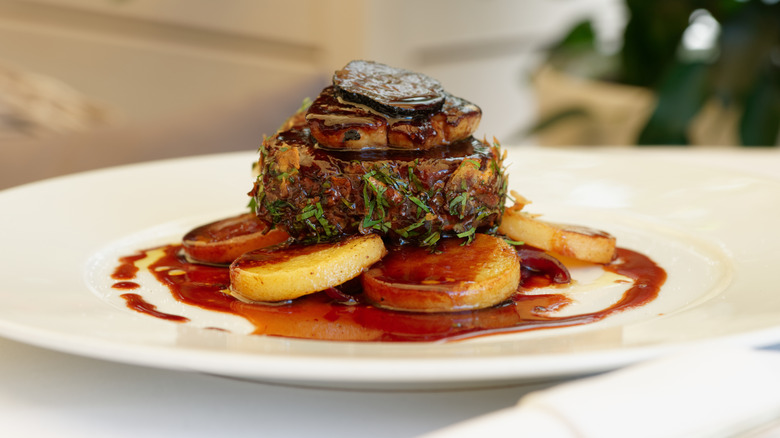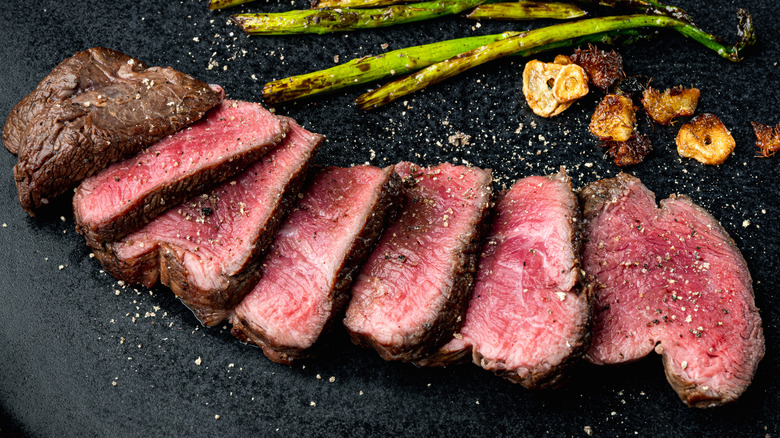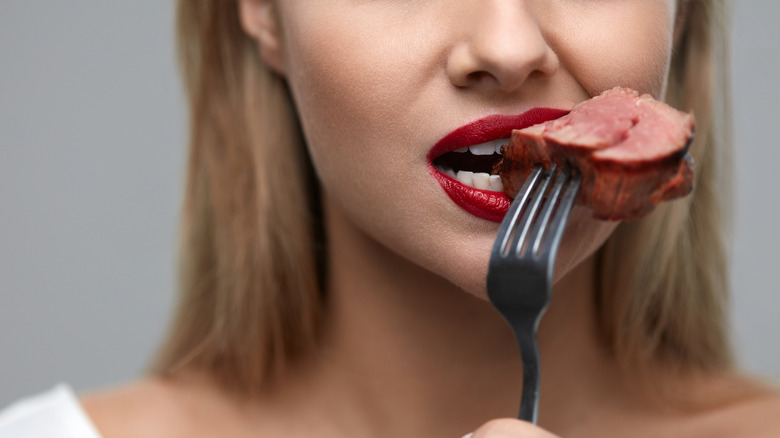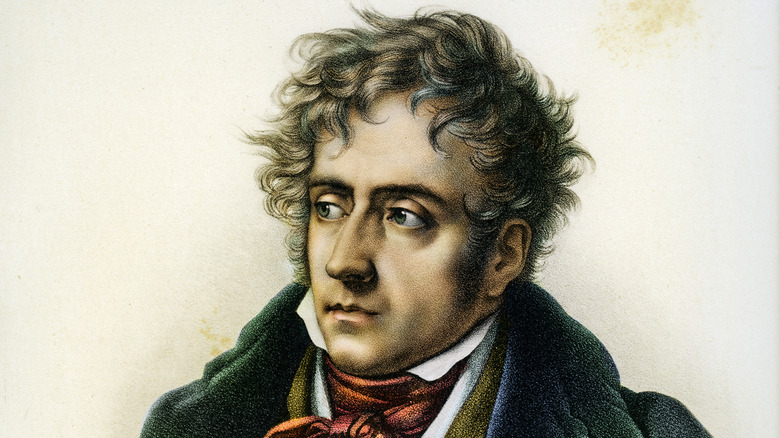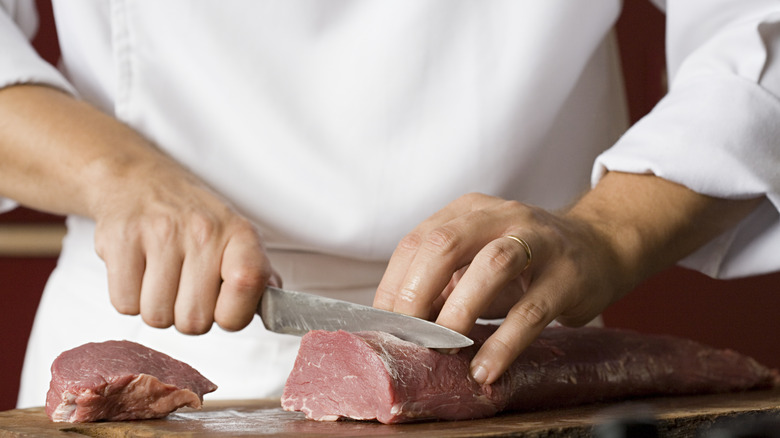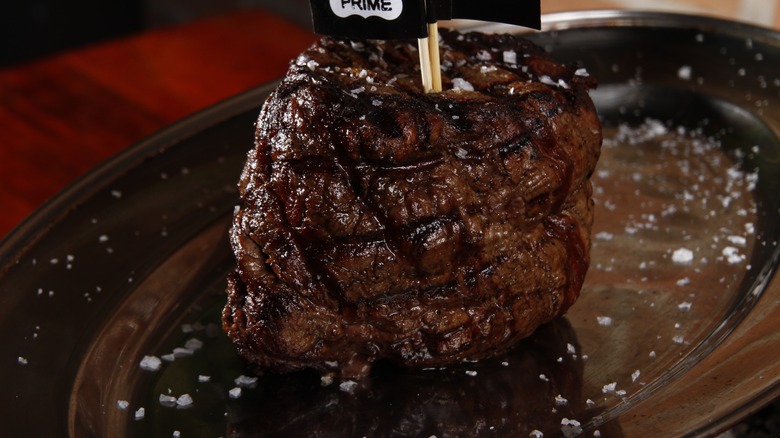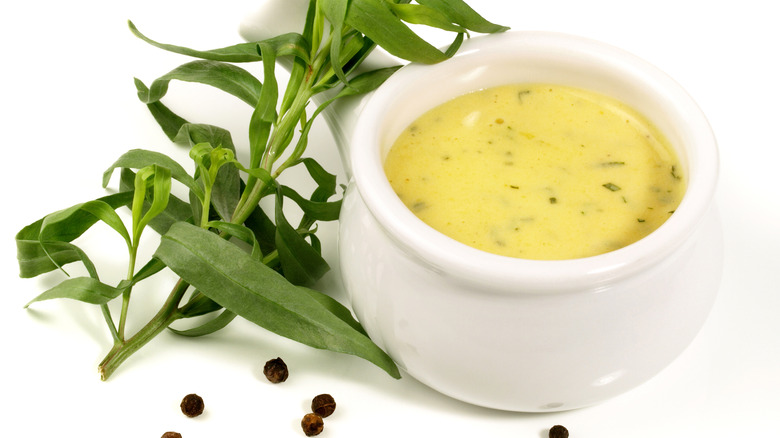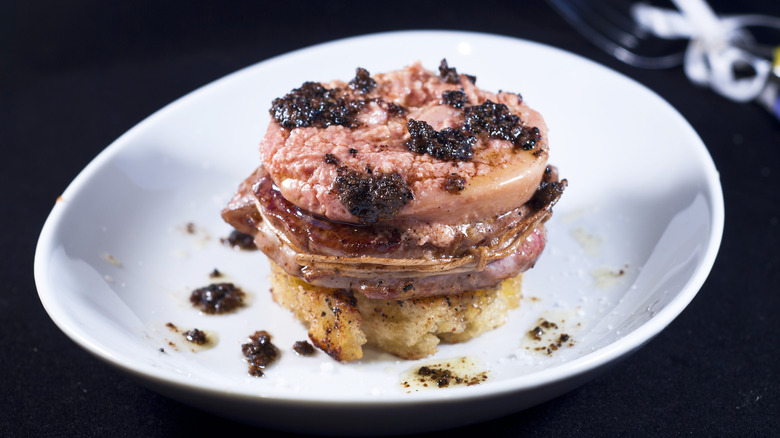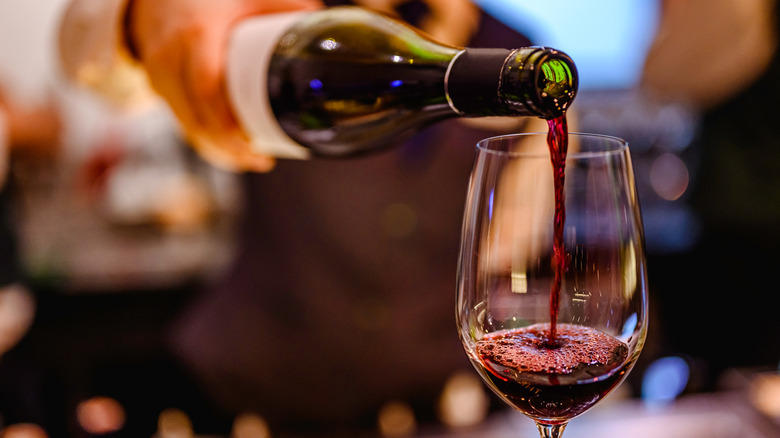What Exactly Is A Chateaubriand?
When you think of a fine dining restaurant, images of white linen tablecloths and napkins come to mind. Fine china, silver flatware, servers wearing suits, and an ambiance bathed with soft lighting and warm wood accents conjure the elegance of a bygone era. The cuisine often gets called "continental," which means everything, and nothing, at once. Technically, the continent it refers to is Europe in general, and French haute cuisine more specifically. Often dishes come with fancy French names that many of us don't comprehend and most of us covet. After all, these dishes are pricey, and a chef with a big, tall hat is preparing them for us.
One such dish, which piques the interest of many while simultaneously perplexing most, is Chateaubriand. What exactly is a Chateaubriand, and is it worth the high price on the menu to order it? Let us demystify this for you and tell you why you should make it a point to have it the next time you celebrate a special occasion at one of these fancy restaurants.
What is Chateaubriand?
Chateaubriand (pronounced shah-toe-bree-ond) is a dish and a preparation method originating in 19th-century France. It is a steak roast typically weighing about 2 pounds, between 3 and 4 inches thick, and sourced from the center cut of the beef tenderloin. This roast, intended to serve two to three people per serving, is generally incorporated as part of a celebratory occasion.
As a cooking method, Chateaubriand was a solution to cooking an oddly shaped and sized cut of meat adequately, without it being over or underdone. The key was to ensure that the center of the roast would be cooked to a perfect medium rare before the exterior became charred. Chefs would achieve this by first stuffing the roast with a delicately spiced mix of beef marrow. Then it would get encased with two more inexpensive cuts of beef that could provide moisture and protect the precious roast. Once cooked to the proper doneness, these encasements would get discarded, and the roast was served with a sauce made of veal stock and tarragon.
Chateaubriand vs. filet mignon
When comparing a Chateaubriand to a filet mignon, how you plan to cook it is critical. Both cuts of meat come from the same part of the cow, namely the beef tenderloin. The tenderloin muscle, located deep within the cow's back, connects the ribcage to the rump. Because this muscle does not get a lot of exercise, it is an incredibly tender cut of meat. The Chateaubriand is cut from the center of the tenderloin, while the filet mignon (cute filet) is a medallion that comes from the tapered ends of the tenderloin.
Aside from size, with the filet being an individual portion versus the Chateaubriand being intended for multiple individuals to consume, a noticeable difference between the two cuts is the amount of subcutaneous fat, or marbling. The filet mignon contains more marbling than the Chateaubriand, making it more tender. Because of this marbling, the filet has more calories and fat per 3-ounce serving than the Chateaubriand, but not by much.
If you are looking for a cut best suited for grilling, smoking, or pan-frying, you should opt for a filet mignon. Its slightly higher fat content makes the filet less challenging to cook at high temperatures and less likely to become dry even if it is overcooked. If you plan to roast your steak, opt for the Chateaubriand, but do your homework, as it can easily be overcooked if not carefully roasted.
What does Chateaubriand taste like?
It may be tempting to say that beef is beef, but anyone who has sampled a ribeye side by side with a filet mignon will understand that the cut of the meat matters where the flavor is concerned. This fact is particularly so with the Chateaubriand. Because of its relatively high fat content and the fact that it comes from a muscle that doesn't do a lot of exercise, its texture practically melts in your mouth. It has a mild beefy flavor but doesn't have an overly aggressive minerally aftertaste like other cuts. Additionally, because this cut of steak gets treated like a roast and baked in the oven, it generally gets caramelized on the outside, giving it a nutty, umami-rich exterior juxtaposed with the slightly sweeter, juicy interior.
If you prefer a cut of meat with a firmer texture and richer meaty flavor, you may opt for a prime rib roast over a Chateaubriand as a holiday treat. The rib roast comes from a muscle that runs the entire length of the back of the cow, from the shoulder blade to the hip bone. This muscle gets significantly more exercise but still has a high fat content. It isn't as delicate a cut as the Chateaubriand, but it may have advantages.
Why is it called Chateaubriand?
Chateaubriand gets its name from the French writer, historian, politician, and aristocrat François-René, Vicomte de Chateaubriand. Monsieur Chateaubriand spent nine years exiled from France beginning in 1791 out of fear of being executed by guillotine during the French Revolution. During his exile, he traveled extensively, writing about his encounters and doing odd jobs to make ends meet. In 1800, Chateaubriand returned to France, eventually becoming a diplomat to Napoleon I. During this time, he was able to secure sufficient status and financial stability to hire a personal chef.
In 1822, this personal chef, one Monsieur Montmireil, developed a dish for his boss, taking a center cut of the tenderloin, encasing it between two lesser cuts of beef, and then discarding these once the tenderloin got cooked to perfection. He served this dish with a sauce and roasted potatoes. The steak was subsequently named "Chateaubriand" after his boss, and a legend was born.
Monsieur Chateaubriand remained in politics until 1836, when he retired and spent the rest of his life writing in solitude. Chateaubriand's grave, on the island of Grand Bé, near Saint-Malo, is often visited by admirers of the man and the meat alike.
Where can you buy Chateaubriand, and how much does it cost?
Purchasing a Chateaubriand steak can be done in a multitude of ways. Several online meat purveyors have perfected the process of shipping meat quickly and safely. Some of these options may be more cost-effective, although shipping cost is a consideration. Those residing in a rural area without a decent grocery store or butcher shop nearby will likely be best off utilizing one of these online resources.
The second option would be a local grocery store with a qualified butcher. Many markets have butchers who can and will cut meat to order. Buying from a grocery store butcher enables you to get the freshest and best quality at a more affordable price. If you have a local butcher shop, we always like to support them, as these are often family owned and operated and can usually source locally grown meat. They tend to be a bit more pricey, but in some ways, you get what you pay for.
Regardless of where you buy your Chateaubriand, this is a costly cut of meat. We saw prices ranging from $90 to $122 per pound on various online resources. Some sources did offer bulk discounts when you order multiple pieces, which may be a good alternative if you plan to feed a large party.
How to cook Chateaubriand
Most recipes for Chateaubriand suggest roasting it in the oven after pan-searing the exterior to seal in flavor and juices. Some basics can be followed to ensure the best-quality final product. First, make sure to bring your meat to room temperature. Cooking meat from a cold state takes longer and yields a less tender final result. Second, pat the steak dry with a paper towel so that it doesn't steam when you place it into the pan to sear it, which yields a nice crust. Third, make sure to season your meat with salt and pepper thoroughly.
Next, don't overcook your meat. There is nothing worse than a dried-out Chateaubriand. Traditionally, it gets served medium rare, meaning the internal temperature of the meat should reach between 125 and 135 degrees Fahrenheit. (Please note, however, that the FDA recommends cooking to an internal temperature of at least 145 degrees for safety reasons.) Finally, rest the steak before slicing. We cover the meat tightly with aluminum foil and give it at least 15 minutes to rest before serving.
Variations of this method also exist. First is barding the Chateaubriand, which involves wrapping it in bacon or some other fat before roasting it to keep it moist. And per early recipes for this dish, you may stuff your Chateaubriand with something like mushrooms rendered down with bacon. However you cook it, consistently test the internal temperature with a meat thermometer.
How should Chateaubriand be served?
Chateaubriand will often be sliced and served on a platter or a wooden cutting board intended for two. This dish is accompanied by a sauce, the most classic being a sauce Béarnaise. Sauce Béarnaise is one of the five classic French mother sauces, a variation on a Hollandaise with shallots and tarragon. Other sauces that are delectable accompaniments to a Chateaubriand include a red wine reduction, a peppercorn sauce, a mushroom sauce, a pan sauce made with Dijon mustard, or a horseradish sauce. Each of these will completely change the experience of eating a Chateaubriand, with heavier creamy sauces muting the richness of the meat and more subtle wine reductions enhancing the umami-rich meaty flavor.
Typical side dishes include roasted potatoes and grilled or sautéed vegetables, like haricots verts. We do not recommend complicated side dishes or spices, which are inauthentic and do not allow the flavor of the meat to shine.
Chateaubriand vs. Tournedos Rossini
Tournedos Rossini is a classic French dish made of two pan-seared filet mignons served atop a slice of toasted bread, topped with seared foie gras, and garnished with a rich Madeira sauce and freshly sliced black Périgord truffles. The dish received its name for renowned Italian composer Gioachino Rossini, a gourmand in his own right. According to lore, Rossini met François-René, Vicomte de Chateaubriand in Verona, Italy, in 1822. After tasting Chateaubriand's namesake dish, Rossini vowed to create a more decadent and ostentatious one.
While he had initially intended to task his best friend, the legendary chef Antonin Carême, with developing the dish, Carême was occupied at the time serving as the personal chef to Britain's ambassador to the Austro-Hungarian Empire. Rossini settled for having another chef comrade invent his namesake dish — Casimir Moissons, the chef of the famed restaurant La Maison Dorée. For a Tournedos Rossini to be authentic, the filet mignon must come from the center of the tenderloin, the same cut that produces at Chateaubriand.
What wine to pair with Chateaubriand
In France, the wine paired with a dish is as important as the dish itself. Therefore, when eating an authentic Chateaubriand, it is imperative that you carefully select an appropriate wine. The basic rule of thumb when eating beef and other red meats is to opt for red wine. If possible, choosing a French wine would be ideal, and depending upon which sauce you opt for (creamy versus wine based), you could select a Burgundy (pinot noir grape), which would be lighter, or a Bordeaux (Cabernet or Merlot grape), which is more robust and tannic.
For a non-French red, we'd recommend a Cabernet Sauvignon, Malbec, Shiraz, Red Zinfandel, or a Meritage (a blend of wines). We'd avoid overly tannic wines like a chianti or heavy Italian Nebbiolo, as the tannins will overwhelm the sauces and the meat. And while white wine is often frowned upon when served with beef, we are mindful that many individuals cannot tolerate red wine for various reasons. In this case, opt for a dry white wine that isn't overly oaked. A New Zealand Sauvignon blanc, Spanish Albariño, or Argentinean Torrontés are all great options.
